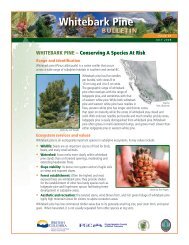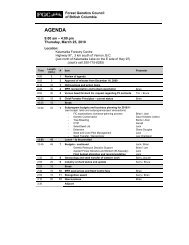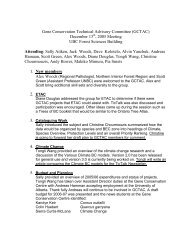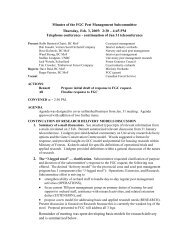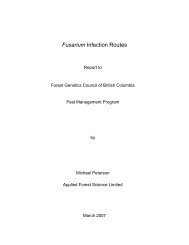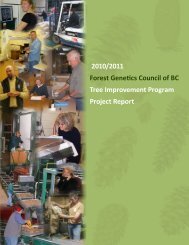Tree Improvement Program Project Report 2006 / 2007
Tree Improvement Program Project Report 2006 / 2007
Tree Improvement Program Project Report 2006 / 2007
You also want an ePaper? Increase the reach of your titles
YUMPU automatically turns print PDFs into web optimized ePapers that Google loves.
standard errors) for each of the 12 lodgepole pine orchards<br />
monitored in <strong>2006</strong>.<br />
Kalamalka produced the highest number of cones (both<br />
orchards) and Prince George, as expected, produced the<br />
fewest. However, any further comparison would be difficult<br />
because we do not have data for crown volume and tree age.<br />
Collecting this data for <strong>2007</strong> may be very helpful.<br />
All data represent one ramet of each of 15 producing<br />
clones. The method may not capture the variation in per<br />
tree seed production among ramets of a clone, nor does<br />
it include typically unproductive clones. However, the 15<br />
trees do allow relative comparisons between orchards for<br />
total seed produced per tree. Data shown in Figure 60 were<br />
calculated using the number of cones per tree (Figure 59)<br />
multiplied by the number of filled seed per cone (Figure<br />
62) determined for the 30-cone sample. Averaged over all<br />
12 orchards, the mean seed production per tree was about<br />
3,200 and the range was 1,057 (ER 310) to 7,155 (KAL<br />
230).<br />
Cone mass varied among orchards, but there was<br />
no relationship between dry cone mass and seed yields.<br />
Further, there was very little variation among orchards (data<br />
not shown).<br />
Cone yields varied considerably, however. Figures 61<br />
and 62 show the total seed per cone (TSPC) and filled seed<br />
per cone (FSPC) respectively for the 30-cone sample from<br />
the 12 selected orchards. Figure 63 shows the percent filled<br />
seed per cone (FSPC/TSPC*100).<br />
Figure 61 shows the total seed per cone (TSPC) for<br />
all 12 orchards. Prince Gorge consistently produced the<br />
highest values (all above 30), but KAL 230 and PRT 313<br />
also produced above the 30 value. All the rest were 20 or<br />
fewer. Since lodgepole pine should have between 30 to 40<br />
potential seed per cone, we must try to explain where the<br />
10 or more TSPC are lost. Since insect bagging occurred<br />
between the second and third week of April, we may infer<br />
that insect predation on unprotected cones may have<br />
affected ovules development (leading to fewer TSPC) as<br />
well as lower filled seed per cone later in June. Inefficiencies<br />
in extraction (tumbling) may account for a few TSPC<br />
losses, but this should be reasonably consistent across all<br />
orchards.<br />
For example, only 10 TSPC were extracted from ER<br />
310 cones. Were there fewer ovules producing fewer<br />
potential seed? Was the pollen cloud limiting (not<br />
according to data shown in the final report)? Was insect<br />
damage a cause (about 10 TSPC were lost when insectbagged<br />
cones were compared to unbagged cones: see<br />
60<br />
T R E E I M P R O V E M E N T P R O G R A M<br />
P R O J E C T R E P O R T 2 0 0 6 / 2 0 0 7<br />
Figure 64). We certainly understand how insect<br />
(Leptoglossus) damage can lower FSPC, but it is not obvious<br />
how insect-protected cones produce about 10 more TSPC.<br />
Filled seed per cone (Figure 62) follows a similar trend<br />
to TSPC. Again Prince George produced the highest FSPC<br />
(all above 20 FSPC), and Kalamalka 230 produced the<br />
highest values (19.4) for the north Okanagan orchards.<br />
Excluding Kalamalka 230, PRT 313 produced the highest<br />
(16.1 FSPC) yields of the north Okanagan orchards, with<br />
FSPC for the remaining orchards ranging between 4.8 and<br />
12.2.<br />
Figure 63 shows the percent filled seed per cone (FSPC/<br />
TSPC*100). All Prince George orchards are near or greater<br />
than 70 percent. Since we assume that cone development<br />
at Prince George is normal, our target for north Okanagan<br />
orchards should be similar. Average percent FSPC for all the<br />
north Okanagan orchards was less than 50 percent (47.1).<br />
However, this statistic is somewhat misleading because both<br />
TSPC (Figure 61) and FSPC (Figure 62) are lower than<br />
expected. If mean TSPC (Figure 61) were about 10 higher,<br />
then percent FSPC would be considerably lower.<br />
One of the principal causes of the loss of seed in the<br />
north Okanagan lodgepole pine seed orchards is insect<br />
predation (Leptoglossus). However, it has been difficult<br />
to quantify these losses across all orchards because both<br />
monitoring of the damage (insect bagging) and control<br />
measures varied considerably. This year, all orchards<br />
followed standardized procedures for monitoring insect<br />
damage.<br />
Figures 64 and 65 show the cone yields (TSPC and<br />
FSPC, respectively) for insect-protected cones (bagged) and<br />
unprotected cones (unbagged). Figures 66 and 67 show<br />
the differences between FSPC and TSPC for bagged and<br />
unbagged cones respectively.<br />
Data (TSPC and FSPC) for unprotected cones shown<br />
in Figures 64 and 65 are similar to the data shown in<br />
Figures 61 and 62, which are based on the 30-cone sample.<br />
To determine the magnitude of the differences in TSPC<br />
and FSPC between bagged and unbagged cones, Figures 66<br />
and 67 show the mean difference for each of the 15 trees in<br />
each of the 12 orchards. The heaviest loss of TSPC occurred<br />
at Kalamalka. Greater than 15 TSPC were lost at Kalamalka<br />
from unprotected cones compared to insect-protected<br />
cones. Eagle Rock lost about 12 TSPC, and the remaining<br />
orchards lost between 5 and 10 TSPC.<br />
Loss of filled seed in unprotected cones also followed the<br />
same trend observed for TSPC. No significant differences<br />
were found for the Prince George orchards (no Leptoglossus



